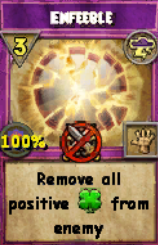September 14, 2012 July 29, 2023
Storm Survivability – Enfeeble
Part 1
The Match: Storm vs. Myth
You are fighting a Conjurer from second… one of a Diviner’s worst possible nightmares. Two Myth Shields spin around your feet, which would have been enough in earlier times. However, in the era of the Basilisk, this no longer suffices. Meanwhile, eight pips glow at the Conjurer’s feet; a mass of blades of different sorts whirl around his head. Even worse, those blades all stack: a Mythblade, a Spirit Blade, a Treasure Spirit Blade, and a Dragonblade.
A single turn stands between you and that deadly Myth serpent. If this were still Level 70 dueling, you would be dead in the water: with this many boosts, the Basilisk could easily do 1500 damage for each of its four hits – and its stun would both prevent Triage from being effective and stop you from recovering until you already took on three of the four hits. Fortunately, you are Archmage now and remember a simple, three-pip spell that you learned at Level 72 just to combat blade-stackers… Enfeeble.
 What is Enfeeble, and Why is it so Awesome?
What is Enfeeble, and Why is it so Awesome?
Enfeeble is a three pip Storm spell which removes all positive charms from the target. This includes all blades and healing boosts, although negative charms like Infections and Weakness stay on.
The reason Enfeeble is such a great spell is that it is an answer to a noob-ish strategy that, while requiring next to no skill or thought, is hard to impossible to defend against. While stacked traps are generally easy to counter (generally one shield for each set will suffice), stacked blades on multi-hit spells are hard to be shielded against because while the blades affect each part of the multi-hit spell (both hits of Orthrus, all 3-4 of a damage over time), each shield only affects a single hit.
Sure, you can try using Weaknesses, but each Weakness counters maybe one blade (a 35% blade and a 25% weakness will nearly exactly cancel each other out), Weaknesses are nearly impossible to stack, and you can easily break a Weakness with an off-school wand while keeping all of your school blades. Think of the last time you faced a Snow Angel boosted by five different sets of blades, and you’ll see what I mean.
However, if your opponent wants to attack immediately after being Enfeebled, the attack will be unboosted and therefore much weaker than originally planned. There is no attack in the game that can one-hit a Diviner with, say, 3000 health and 30% resist without any blades or auras (with very few exceptions, all of which involve unblocked Critical hits) – so if your opponent has intended to stack blades for a one-hit kill as a main strategy, you will survive that one hit and almost definitely be able to move right away to the offensive.
When to Use It
There is a risk about casting Enfeeble from second: if you wait too late, your opponent might have already attacked. This means that not only did your opponent’s attack come fully bladed, but you have wasted three pips on attempting to prevent it. Enfeeble from second works best if you can tell that the opponent will not attack this turn. Alternatively, you might choose to cast the spell when you know that an attack this turn would not really do enough damage to be worth it. That way, even if you did guess wrong, you are still alive and, having only spent three pips against your opponent’s seven to nine, you are still ahead in pips!
Storm: Survival Skills
Returning to the match, you select your spell. Your opponent casts one more buff, a Treasure Mythblade, and then you cast your Enfeeble and smirk as all the Conjurer’s blades get destroyed: the Mythblades, the Spirit Blades, and the Dragonblade. Even though your opponent has enough pips to cast Basilisk, it would now only do about 1500 health TOTAL through your resist, even not counting the shields. You breathe a sigh of relief: no matter what, you know you will live to see another turn.
But how will the match continue? Find out in Part 2!